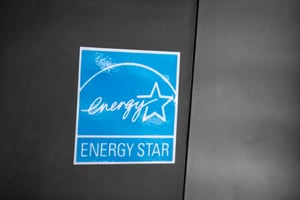Congratulations to Los Angeles, which has topped the U.S. Environmental Protection Agency’s list of cities with the greatest number of ENERGY STAR certified commercial and multifamily buildings in 2022.
The city won the top spot for the fourth year in a row with nearly 750 ENERGY STAR certified buildings. Washington, D.C., and Atlanta followed with 555 and 376 buildings, respectively.
According to the EPA, commercial buildings account for 16% of the nation’s greenhouse gas emissions and spend more than $190 billion per year on energy. ENERGY STAR certified buildings use an average of 35% less energy and are responsible for 35% less carbon dioxide emissions than typical buildings.
As our hometown, we’re excited to see more Los Angeles-area businesses taking an important step in protecting the environment and contributing to a more sustainable future. Los Angeles isn’t alone, however. More and more companies across the United States are taking steps to improve their eco-sustainability through ENERGY STAR programs, update their waste management processes, and integrate renewable energy sources into their industrial processes.
It’s an exciting time for businesses looking for ways to make an environmental impact. Here are the cities leading the charge, why sustainable companies have an advantage and how your business can stop energy waste.
Cities With The Most ENERGY STAR Certified Buildings
The EPA began releasing lists of the cities with the most ENERGY STAR certified buildings in 2009. To create the annual list, the EPA tallies the number of certified buildings within each metropolitan area (defined by the U.S. Census and includes the city itself and surrounding suburbs).
This year’s list includes buildings that earned EPA’s ENERGY STAR in 2022.
This year’s Top 25 Cities are:
|
Rank |
Metro Area |
Building Count |
Last Year's Rank |
|
1 |
Los Angeles |
748 |
1 |
|
2 |
Washington DC |
555 |
2 |
|
3 |
Atlanta |
376 |
3 |
|
4 |
San Francisco |
343 |
4 |
|
5 |
New York |
256 |
6 |
|
6 |
Riverside |
230 |
18 |
|
6 |
Denver |
230 |
8 |
|
8 |
Dallas |
221 |
5 |
|
8 |
Chicago |
221 |
7 |
|
10 |
Boston |
205 |
10 |
|
11 |
Houston |
195 |
9 |
|
12 |
Tampa |
184 |
15 |
|
13 |
Seattle |
180 |
13 |
|
14 |
San Diego |
170 |
11 |
|
15 |
Austin |
168 |
12 |
|
16 |
Minneapolis |
156 |
14 |
|
17 |
Phoenix |
131 |
16 |
|
18 |
San Jose |
110 |
16 |
|
19 |
Charlotte |
105 |
19 |
|
20 |
Miami |
94 |
20 |
|
21 |
Sacramento |
88 |
23 |
|
22 |
Philadelphia |
76 |
22 |
|
23 |
Orlando |
64 |
24 |
|
24 |
Portland |
63 |
N/A |
|
25 |
Raleigh |
59 |
N/A |
|
25 |
Cincinnati |
59 |
25 |
Top 10 Mid-Sized Cities:
|
Rank |
Metro Area |
Building Count |
Last Year's Rank |
|
1 |
Raleigh, N.C. |
59 |
3 |
|
2 |
Des Moines, Iowa |
49 |
9 |
|
3 |
Provo, Utah |
47 |
2 |
|
4 |
Grand Rapids, Mich. |
37 |
n/a |
|
5 |
Bakersfield, Calif. |
35 |
n/a |
|
5 |
Salt Lake City, Utah |
35 |
8 |
|
5 |
Louisville, Ky. |
35 |
4 |
|
8 |
Boulder, Colo. |
31 |
6 |
|
8 |
Milwaukee, Wis. |
31 |
n/a |
|
10 |
Visalia, Calif. |
27 |
n/a |
Top 10 Small Cities:
|
Rank |
Metro Area |
Building Count |
Last Year’s Rank |
|
1 |
Jackson, Mich. |
41 |
1 |
|
2 |
Sioux City, Iowa |
16 |
3 |
|
3 |
Punta Gorda, Fla. |
13 |
n/a |
|
4 |
Dubuque, Iowa |
12 |
n/a |
|
5 |
Saginaw, Mich |
11 |
7 |
|
5 |
Carson City, Nev. |
11 |
4 |
|
7 |
Elizabethtown, Ky. |
10 |
4 |
|
7 |
Midland, Mich. |
10 |
n/a |
|
9 |
Owensboro, Ky. |
9 |
n/a |
|
10 |
Richmond-Berea, Ky |
8 |
n/a |
The number of buildings across the country that have earned the EPA’s ENERGY STAR certification is even more impressive. In 2022 alone, more than 7,000 commercial buildings earned the designation. That brought the number of buildings across America that have earned ENERGY STAR certification to 41,000 in total.
According to the EPA, these buildings have saved $5.4 billion on energy bills and prevented more than 22 million metric tons of greenhouse gas emissions.
How A Business Earns ENERGY STAR Certification
To earn the ENERGY STAR certification, a commercial building must achieve a score of 75 or higher on the EPA’s scale that ranges from 1 to 100. A score of 75 indicates that a building is more efficient than 75% of similar buildings nationwide. What determines that score is based on a number of factors, including:
that ranges from 1 to 100. A score of 75 indicates that a building is more efficient than 75% of similar buildings nationwide. What determines that score is based on a number of factors, including:
- Energy use
- Hours of operation
- Number of employees
- Climate
Ways to improve your score will vary based on operations, but simple adjustments you can make now include:
- Improving your insulation to minimize air leaks and heat transfers
- Using ENERGY STAR certified appliances
- Getting an audit on your building to understand what changes you need to make and get a better idea of how your larger systems (HVAC, lighting, etc.) are operating
- Install LED light bulbs and set timers so lights are on only when rooms are occupied
It’s also helpful if you can sign up for utility bill management in which you can use software to see abnormally high values or determine how your building is performing at a certain time or day during the week.
Why Sustainable Companies Have An Advantage
Businesses that incorporate sustainable practices into their operations can gain a competitive edge over those that don’t. Sustainable practices not only benefit the environment but also improve a company’s image, reduce costs and help businesses stay ahead of changing regulations.
Consumers are also increasingly choosing to purchase goods and services from sustainable companies. A survey by the Natural Marketing Institute found that nearly 60 percent of consumers are more likely to purchase goods and services from a company that practices sustainability.
Implementing sustainable practices can create more efficient operations, reduce waste disposal costs and save money on supplies as well. Businesses that integrate sustainable practices into their operations will be better positioned to adapt to new regulations in a timely and less costly manner.
How To Stop Energy Waste
How can your business make a difference in stopping energy waste? Sustainable practices can include implementing a recycling program, using Energy Star appliances, embracing advanced technologies, reducing business travel, setting up commuting programs for employees and working with suppliers who practice sustainability.
Another way you can improve your company’s sustainability is to take a closer look at your waste management. Although your waste is disposed of off-site, the decisions you make regarding how you manage your waste impact your level of sustainability.
Any waste your facility generates, from wastewater to solid waste or hazardous waste, must go somewhere and be treated. The treatment of that waste before it can be disposed of uses a substantial amount of electricity.
Let’s take a look at wastewater alone. According to the U.S. Department of Energy, municipal wastewater treatment plants consume an estimated 30 terawatt hours or more per year of electricity. This equates to about $2 billion in annual electric costs!
Then you have the transportation for that waste and the energy used to refine gasoline for the trucks that transport your waste.
It can be challenging to take a hard look at the energy your company uses directly and indirectly on a daily basis. However, a reputable waste disposal company can work with you to develop a more sustainable solution for your waste.
Hazardous waste disposal companies that offer a walk-through program can evaluate your waste procedures to ensure they are environmentally friendly and help you look for ways to reduce waste. They can also work with you to determine where you want your waste sent and by which method you wish to have it disposed of in order to align with your waste management and sustainability goals.
Walk-through programs are not audits of your operations. In fact, these programs are consultative in nature. They not only help ensure you are operating in compliance with state and federal laws, they can even help you improve your sustainability initiatives so you can get one step closer to being one of the companies on the ENERGY STAR list above.


Comment